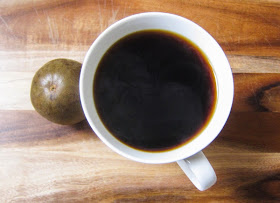 |
| Luo han guo tea / monk fruit tea. |
Here's another beverage that came about while I was clearing out my cupboards for the big move.
When my parents visit me every now and then in Melbourne, they invariably stock up my fridge and my pantry in their efforts to look after me. One of the ingredients they provided one time was dried luo han guo (also known as monk fruit, buddha fruit, or arhat fruit). The luo han guo beverage is something I drank often back in Malaysia, yet it was always prepared by someone else. I never got around to making it myself - so as an ingredient, the monk fruit remained so enigmatic to me.
But I was moving house and I couldn't bear to throw it away. That's as good a time as any to get out of my comfort zone, right? I vaguely remembered my mum's reassurances: "It's really easy to make luo han guo tea, just crack the fruit and simmer it in water until the flavour comes out."
So that was what I did, and it was truly that easy. Like so many things, it's not as scary or as mysterious as it seems, once you actually try it.
 |
| Dried luohanguo / dried monk fruit. |
luo han guo tea / monk fruit tea
Use approximately 1 litre, or 4 cups of water, for every piece of whole dried monk fruit. Break open the fruit with your hands, so that the dried flesh inside gets some exposure. Bring the fruit and the water to boil in a pot, then cover and allow it to simmer for at least 20 minutes. The longer you cook it, the more intense the flavour is. If it becomes too strong, simply add more water to dilute it.
As monk fruit is naturally very sweet, there should be no need to add any sugar. Strain out any bits and pieces of the broken fruit, and the tea is ready to enjoy immediately if you wish. This is a beverage which is delicious with its sweet herbal quality, at all temperatures. I had it hot on this occasion, but I love it really cold with ice.
Note: I just asked my mum and she generally uses 1.5 - 2 litres (6 - 8 cups) of water for each fruit, and simmers it for around an hour. I guess mine is the shortcut method, haha!
 |
| Luo han guo beverage / monk fruit beverage. |
I wonder what fruit is that.. I don't think I have tried or seen such fruit :)
ReplyDeleteI think I've only seen the dried fruit (as shown in the pictures). Would like to see the fresh fruit someday!
DeleteSuch a healing drink... and I'm all for shortcut methods, ha ha ha! It's important we do so because we now lead such busy lives with work and all.
ReplyDeleteHa, yes! To be honest I can't even remember how long I cooked mine. Just let it simmer for a while and do a taste test, easiest ever.
DeleteI've only ever had the version from a concentrate, like a little cube that you mix with water (like a stock cube!), but never the fresh version.
ReplyDeleteAnyhow I have to say, this is one of those Chinese concoctions that I do not enjoy =S
Hehe, I like this concoction, and even more so with sea coconut, served with ice. :D
DeleteIt's good to step out of your comfort zone! this tea looks delicious!
ReplyDeleteThank you! :)
DeleteAre we allowed to bring lo han guo into Australia from Malaysia?
ReplyDeleteWill the custom stop us?
Thank you!
Hello, I am not really sure. It might be okay if it is packed well and sealed securely. But otherwise, I think you should be able to find it in the more comprehensive Asian grocery stores, or herbal medicine stores in suburbs with a big Asian population.
DeleteYes, here in the suburbs of New Jersey (USA) , there’s a Chinese grocery store, with all kinds of interesting fresh fruits and veg, fish etc, and they sell dried luo han, at a very reasonable price.
DeleteHi Leaf,
ReplyDeleteThank you so much for your reply.
Noted.
Best regards,
I use 1000g of water for each fruit (20g).
ReplyDeleteI'm not sure if this site is still monitored... I would like to know how can I use this fruit in baked goods.. I do have the fruit, and would like to use it... thanks!
ReplyDeleteHi, I just saw your comment. I've never tried baking with luohanguo, but that sounds like an interesting challenge! You might be able to use this tea as the liquid component in baked goods. Otherwise, you're going to have to separate the pulp/flesh somehow to use it, which may be quite tricky.
Delete